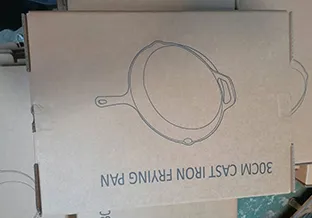
seasoning cast iron pan
The Art of Seasoning a Cast Iron Pan
Cast iron pans have long been cherished by home cooks and professional chefs alike for their durability and exceptional heat retention. However, one critical aspect that determines the performance and longevity of a cast iron pan is its seasoning. This age-old process not only enhances the pan's non-stick properties but also protects it from rust. Understanding how to properly season a cast iron pan can significantly elevate your cooking experience.
What is Seasoning?
Seasoning is the process of applying a layer of oil to a cast iron pan and heating it to create a natural non-stick surface. This layer of polymerized fat creates a protective coating that prevents food from sticking and shields the pan from moisture, which is a leading cause of rust. A well-seasoned pan becomes a treasured kitchen companion, improving with each use.
Choosing the Right Oil
The type of oil you select for seasoning is crucial. Many cooks prefer oils with a high smoke point, such as flaxseed oil, grapeseed oil, or vegetable oil. Flaxseed oil is particularly popular because it dries to a hard finish, providing a resilient surface. However, oils like canola or avocado oil can work just as well, depending on your preference and availability. Regardless of the oil you choose, ensuring it's high in unsaturated fats can lead to a better seasoning layer.
The Seasoning Process
1. Clean the Pan If you're starting with a new pan or one that hasn't been used in a while, give it a good scrub with warm soapy water. This is often the only time soap is recommended for cast iron, as it helps to remove any residue from manufacturing or previous uses. Rinse and dry thoroughly.
seasoning cast iron pan

2. Apply Oil Pour a small amount of your chosen oil onto a paper towel or cloth and rub it all over the surface of the pan, including the handle and the outside. Make sure to use a thin, even coat. Wipe away any excess oil; a thick layer can lead to a sticky finish.
3. Heat the Pan Preheat your oven to about 450°F (230°C). Place the pan upside down on the middle rack with a baking sheet or aluminum foil beneath it to catch any drips. Bake for about an hour. This high heat helps the oil to polymerize and bond with the iron.
4. Cool Down After an hour, turn off the oven and let the pan cool inside. This gradual cooling process helps to strengthen the seasoning layer.
Maintaining Your Seasoned Pan
Once seasoned, your cast iron pan requires some routine care to maintain its surface. Avoid harsh detergents and instead use hot water and a stiff brush for cleaning. After washing, dry the pan on the stove over low heat and apply a thin layer of oil to preserve the seasoning.
Conclusion
Properly seasoning a cast iron pan is a straightforward but essential skill for every home cook. With the right oil and technique, you can create a pan that not only lasts for generations but also enhances the flavors of your dishes. Embrace the artistry of seasoning, and you’ll find that your cast iron skillet becomes an irreplaceable part of your culinary toolkit. Happy cooking!
-
Season Cast Iron Perfectly with GPT-4 Turbo TipsNewsAug.01,2025
-
High Quality Cast Iron Cookware - Baixiang County Zhongda MachineryNewsAug.01,2025
-
Premium Cast Iron Pan: Durable & Perfect HeatNewsAug.01,2025
-
High Quality Kitchen Durable Black Round Cast Iron Cookware Pancake Crepe Pan-Baixiang County Zhongda Machinery Manufacturing Co., Ltd.NewsAug.01,2025
-
Cast Iron Cookware - Baixiang County Zhongda Machinery | Nonstick, Heat ResistanceNewsAug.01,2025
-
High Quality Kitchen Durable Black Round Cast Iron Cookware - Baixiang County Zhongda Machinery | Non-Stick, Heat Retention, DurableNewsJul.31,2025


